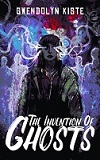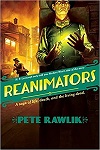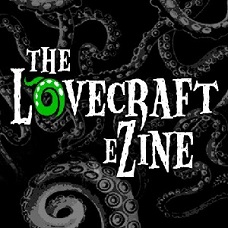 I greatly enjoyed Pete Rawlik’s Reanimators. That novel followed Dr. Stuart Hartwell as he attempted to perfect his re-agent, a serum to cure death, while competing with H.P. Lovecraft’s Herbert West. Hartwell’s adventures gave readers new perspectives from which to view some of Lovecraft’s work. For instance, Hartwell plays a small part in the creation of the titular Dunwich Horror. I talked about my enjoyment of Reanimators in my Summer Reading Roundup last year, but now I’m ready to discuss the sequel, The Weird Company: The Secret History of H.P. Lovecraft’s Twentieth Century.
I greatly enjoyed Pete Rawlik’s Reanimators. That novel followed Dr. Stuart Hartwell as he attempted to perfect his re-agent, a serum to cure death, while competing with H.P. Lovecraft’s Herbert West. Hartwell’s adventures gave readers new perspectives from which to view some of Lovecraft’s work. For instance, Hartwell plays a small part in the creation of the titular Dunwich Horror. I talked about my enjoyment of Reanimators in my Summer Reading Roundup last year, but now I’m ready to discuss the sequel, The Weird Company: The Secret History of H.P. Lovecraft’s Twentieth Century.
I should think it goes without saying, but if you want to truly enjoy Reanimators and The Weird Company, you’ll need to be familiar with the works of H.P. Lovecraft. Whereas Reanimators primarily drew on Lovecraft’s schlocky Frankenstein tale, Reanimator, The Weird Company takes most of its major inspiration from At the Mountains of Madness. Rawlik doesn’t just draw from At the Mountains of Madness though. Characters and references from The Shadow Over Innsmouth, The Thing on the Doorstep, Dreams in the Witch House, The Hounds of Tindalos, The Blob, John Carpenter’s The Fog, The Dream Quest of Unknown Kadath, Through the Gates of the Silver Key, and The Strange High House in the Mist appear within the pages of the Weird Company. And those are just the characters and references I identified, and remembered, while writing my review.
Minor Spoilers Below
In The Weird Company, Shoggoths, protoplasmic monsters, are working to abscond from their icy solitude in Antarctica. Their escape from the frozen continent will spell doom for humanity. The only force standing in the Shoggoths’ path is the Weird Company, a group of unlikely heroes who I think of as The League of Extraordinary Gentlemen if Alan Moore drew from Lovecraft stories instead of classic fiction. The narrative is relayed via diary entries from several members of the Weird Company, mostly from Robert Olmstead, the protagonist from The Shadow Over Innsmouth. Together the group travels to Antarctica and battles to keep the Shoggoths from escaping.
Rawlik adds several new twists and connections into Lovecraft’s existing canon. Some purists might be skeptical of these, but I liked all of the fresh inclusions. One fascinating link Rawlik makes is between the blood of the Elder Things, creatures from At the Mountains of Madness, and the re-agent created by Herbert West and Dr. Stuart Hartwell. The Elder Things can enter stasis and effectively live forever, and the re-agent preserves and revives, so it makes sense the two substances would be similar. Rawlik also manages to make the Elder Things rather terrifying in their locomotion, a feat infinitely impressive considering Lovecraft’s original descriptions of their alien forms. At the end of the book, there’s also a ghoulish twist to the Elder Sign, which is traditionally portrayed as a protective ward.
My review is quickly devolving into a lunatic’s raving, and I’d prefer to avoid being committed to the Arkham Sanitarium, but I have a few last thoughts before I end. The climax of the story is a ton of fun, if like me, you’re a fan of cats, specifically The Cats of Ulthar. Oliver Wyman does an outstanding job narrating The Weird Company on Audible. He did the same for Reanimators. Lastly, don’t forget to check out Pete Rawlik’s latest Lovecraftian installment, The Miskatonic University Spiritualism Club. The book is now available for pre-order from Jackanapes Press.





 For a while, I’d been thinking, why hasn’t anyone done a story that pulls together a bunch of Lovecraft’s connected mythos into a singular tale? Well, I had somehow foolishly missed out on Reanimators existence until recently. The novel weaves the tale of Dr. Stuart Hartwell, a contemporary of Herbert West, as he moves through the years in and around Arkham. In the narrative, Hartwell encounters several of Lovecraft’s most famous characters and even intersects with several of Lovecraft’s best tales. This was a ton of fun to read, and I can’t wait to dive into the sequel. Maybe one day I’ll do a post trying to diagram out all the references and Easter eggs. Indiana Jones even pops up in the text.
For a while, I’d been thinking, why hasn’t anyone done a story that pulls together a bunch of Lovecraft’s connected mythos into a singular tale? Well, I had somehow foolishly missed out on Reanimators existence until recently. The novel weaves the tale of Dr. Stuart Hartwell, a contemporary of Herbert West, as he moves through the years in and around Arkham. In the narrative, Hartwell encounters several of Lovecraft’s most famous characters and even intersects with several of Lovecraft’s best tales. This was a ton of fun to read, and I can’t wait to dive into the sequel. Maybe one day I’ll do a post trying to diagram out all the references and Easter eggs. Indiana Jones even pops up in the text. Silver Bullet is one of my favorite horror films of all time. A big part of why I love this movie so much is tied to the fact that I saw it at a young age, but I also think it’s a brilliant gem. The way the movie builds dread as it slowly progresses toward the climax, the excellent performances, and the way the werewolf’s killings impact the small town of Tarker’s Mill combine to make Silver Bullet special. So, it was only a matter of time until I read Cycle of the Werewolf. While I enjoyed the novella, I felt the story worked better as a screenplay. The close bonds between Marty and his sister, and Marty and his uncle, weren’t present in Cycle of the Werewolf, and they’re a major reason why I love Silver Bullet. The story felt hollow without them. Although, the movie didn’t have the stellar art by Bernie Wrightson.
Silver Bullet is one of my favorite horror films of all time. A big part of why I love this movie so much is tied to the fact that I saw it at a young age, but I also think it’s a brilliant gem. The way the movie builds dread as it slowly progresses toward the climax, the excellent performances, and the way the werewolf’s killings impact the small town of Tarker’s Mill combine to make Silver Bullet special. So, it was only a matter of time until I read Cycle of the Werewolf. While I enjoyed the novella, I felt the story worked better as a screenplay. The close bonds between Marty and his sister, and Marty and his uncle, weren’t present in Cycle of the Werewolf, and they’re a major reason why I love Silver Bullet. The story felt hollow without them. Although, the movie didn’t have the stellar art by Bernie Wrightson.




